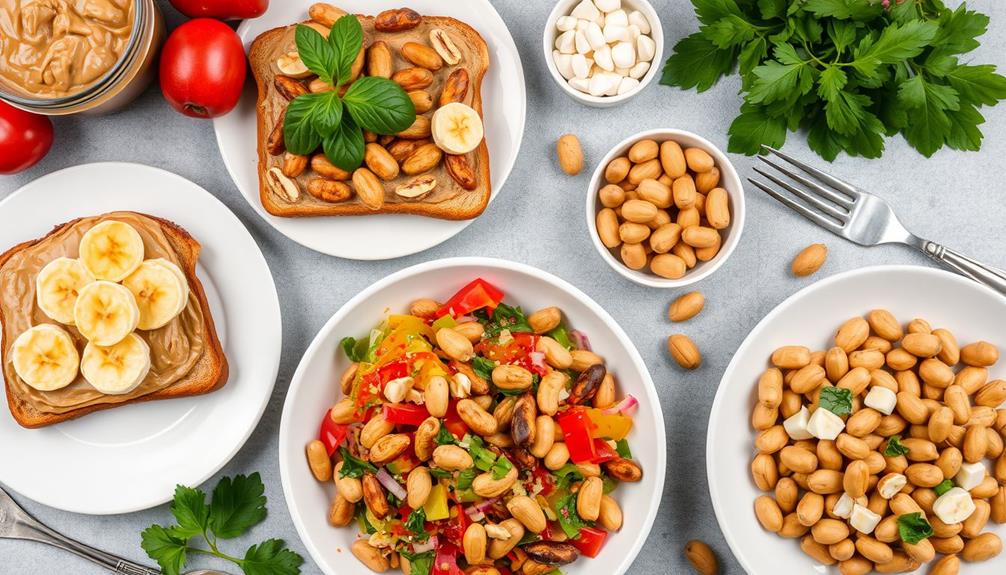Baby-led weaning with beetroot can be a fun and nutritious experience for your little one. You can introduce beets around 6 months, ensuring they're soft and easy to grasp. Beets are packed with essential nutrients like folate and fiber, promoting healthy growth and digestion. Choose fresh, tender beets, and prepare them by steaming or roasting until soft. For exciting meals, try recipes like beet and apple puree or colorful fritters. Always store leftovers properly to keep them fresh. As you explore, you'll discover even more tips and tricks to make beetroot a staple in your baby's diet.
Key Takeaways
- Introduce beets around 6 months, ensuring babies can sit up and show interest in solids; consult a healthcare provider first.
- Beets are nutrient-dense, offering folate, fiber, potassium, iron, and calcium, promoting growth and digestive health.
- Prepare beets safely by cooking until soft, cutting them into thin strips, and gradually introducing to monitor for allergic reactions.
- Serve beets in age-appropriate textures; puree for 6 months, mash for 9 months, and thin slices or shreds for 12-18 months.
- Explore creative recipes like beet and apple puree, nutritious pancakes, and beet hummus to make mealtime enjoyable.
When Can Babies Eat Beets?
Most babies can start enjoying beets around 6 months old, when they show signs of being ready for solid foods, like sitting up and expressing interest in what you're eating.
It's an exciting time as you begin the weaning process, and beets can be a great addition to your baby's diet. Introducing new foods early on may also support healthy development, as mental health support is essential for those at risk of cognitive decline later in life.
Before introducing cooked beets, it's a good idea to consult your healthcare provider to make certain this new food aligns with your baby's dietary needs. Beets are generally safe for babies over 6 months, presenting minimal allergenic concerns.
Just remember to serve them in appropriate sizes and textures to prevent choking. Cooking methods like steaming or roasting will help you create soft beets that are easy for your baby to chew and digest.
Start with small, manageable pieces, and gradually introduce them into your baby's meals. This way, you can monitor for any potential adverse reactions.
As your baby becomes accustomed to the taste and texture of beets, you'll find that they can be a nutritious and colorful addition to their weaning journey. Enjoy this fun and messy phase of exploring new flavors together!
Health Benefits of Beets

When you introduce beets to your baby, you're offering a powerhouse of nutrients.
These vibrant vegetables pack a punch with essential vitamins and minerals while providing antioxidant properties that support their growing bodies. Incorporating beets into your child's diet can also promote overall health and well-being, particularly through holistic lifestyle approaches that alleviate various health concerns.
Plus, their low-calorie content makes them an excellent choice for baby-led weaning.
Nutrient Density Overview
Nutrient density is a fundamental consideration when introducing solid foods to your baby, and beetroot stands out as a powerhouse of essential nutrients. When you choose beets for baby-led weaning, you're providing a wealth of health benefits that support your little one's growth and development.
- Folate: Beets are rich in folate, essential for brain and spinal cord development, which is important for cognitive growth in infants.
- High Fiber Content: The fiber in beets promotes healthy digestion, ensuring regular bowel movements that are vital for babies moving to solid foods.
- Low-Calorie Option: With only 24 calories per serving, beets deliver nutrient density without excessive energy intake, making them a smart choice for healthy foods.
- Essential Minerals: Beets are packed with potassium, iron, and calcium, supporting overall health and development in your baby.
Incorporating beets into your baby's diet can boost their nutrient intake while promoting digestion and overall well-being.
Antioxidant Properties Explained
Beetroot isn't just a nutritious option for baby-led weaning; it's also packed with powerful antioxidants that provide significant health benefits. One of the key components in beetroot is betalains, which are known for their ability to combat oxidative stress and inflammation. This means that when you introduce beetroot to your little one, you're not just offering them an earthy flavor; you're also giving them a boost to their overall health.
The vibrant color of beets signals their high antioxidant content, particularly betacyanin, which has been shown to reduce inflammation and potentially lower the risk of chronic diseases. By regularly incorporating beetroot into your baby's diet, you can enhance their body's antioxidant defenses, supporting immune function and promoting wellness.
Moreover, beetroot is rich in nutrients that aid in liver detoxification, further contributing to its health benefits.
Selecting Fresh Beetroots

Selecting fresh beetroots can make all the difference in your baby-led weaning journey. When you're choosing beetroots, keep these key points in mind to guarantee they're packed with flavor and nutrients:
- Firmness and Skin: Look for beetroots that are firm and smooth-skinned, as these signs indicate freshness and sweetness. Additionally, selecting organic beetroots can enhance your baby's exposure to nutrient-rich foods while avoiding harmful chemicals, allowing you to embrace a more holistic approach to natural alternatives.
- Size Matters: Opt for small to medium-sized beets; they tend to be more tender and less fibrous than their larger counterparts.
- Check the Greens: If the greens are still attached, make sure they're crisp and dark green. This indicates the beetroots are fresh and nutrient-rich.
- Signs of Spoilage: Avoid any beetroots with soft spots, shriveling, or mold, as these are clear signs of spoilage.
Don't hesitate to explore different beet varieties like golden or white beets. They offer unique flavors and additional nutritional benefits, making your baby-led weaning experience diverse and enjoyable.
Safe Preparation for Babies

To guarantee your baby enjoys beets safely, it's vital to prepare them correctly. When engaging in baby-led weaning, make certain you cook beets until they're soft and easily mashable. This reduces choking hazards and promotes safe self-feeding.
Incorporating a variety of foods, including beets, can enhance your baby's nutritional intake and contribute to a well-rounded diet, as seen in diversification of retirement portfolio strategies. After cooking, always remove the skin, as it can be tough for little ones to chew, enhancing their eating experience.
Cut the cooked beets into long, thin strips or wedges to give your baby a better grip. This makes it easier for them to pick up the finger foods and encourages independence during mealtime.
Introduce beets gradually to monitor allergic reactions, and serve them in age-appropriate textures based on your child's developmental stage.
If you have any leftover cooked beets, store them in airtight containers in the fridge for up to 3-5 days. Alternatively, you can freeze them in ice cube trays for convenient portions later.
Following these safe preparation tips will help guarantee your baby's first experience with beets is enjoyable and safe, setting them up for a lifetime of healthy eating habits.
Cooking Methods for Beets

Cooking beets offers a variety of methods that can enhance their flavor and texture, making them more enjoyable for your baby. Each cooking method has its unique benefits, especially when it comes to baby-led weaning.
For instance, when selecting ingredients for your baby's meals, it's important to take into account vegan-friendly options that promote a healthy diet. Here are four popular cooking methods for beets:
- Steaming: This method preserves the nutrients best. Cut beets into cubes and steam them for 15-20 minutes until they're tender and easily mashable.
- Boiling: You can boil whole, unpeeled beets for 20-30 minutes. The skin helps retain nutrients, and you can peel them before or after boiling.
- Roasting: To bring out their natural sweetness, wash, peel, and cut the beets into pieces. Toss them in olive oil and roast at 195°C (380°F) for 30-40 minutes until they're tender.
- Baking: Similar to roasting, baking beets can also enhance their flavor while keeping them soft and safe for your baby to chew and digest.
Cooking beets until they're soft is essential for making them safe and easy for your little one to enjoy during baby-led weaning.
Age-Appropriate Serving Suggestions

Once you've mastered the various cooking methods for beets, it's important to think about how to serve them at different stages of your baby's development. For babies around 6 months, serve cooked beetroot in soft slices or pureed. This encourages exploration of texture and flavor, which is vital during baby-led weaning.
Additionally, introducing colorful vegetables like beetroot can make mealtime more engaging for your little one, promoting interest in a variety of foods. Consider checking out Charming female dog names for inspiration if you have a new pet joining the family.
At 9 months, you can mash the cooked beetroot and mix it with grains or proteins to create a thicker consistency that fosters self-feeding. This helps them practice their motor skills while enjoying nutritious meals.
From 12 to 18 months, offer thin slices or shreds of beetroot to help develop utensil skills and encourage independent eating. Finger foods like beet fritters or roasted beet strips are excellent choices for toddlers, enhancing their self-feeding abilities while making mealtimes fun.
Always verify the texture is appropriate for your baby's developmental stage to minimize choking hazards. By providing age-appropriate serving suggestions, you not only support their nutritional needs but also help foster healthy eating habits from an early age.
Beetroot Juice for Infants

Introducing beetroot juice can be a nutritious addition to your baby's diet after they hit the 6-month mark, but it's essential to prepare it properly. Beetroot juice, known for its vibrant color, is rich in nitrates, which can benefit blood flow and overall health when introduced correctly.
Here are some important tips to keep in mind when introducing this vibrant juice:
- Diluting the Juice: Always dilute beetroot juice with water or other juices to lower sugar and nitrate levels. This makes it gentler on your infant's digestive system.
- Watch for Allergic Reactions: Monitor your baby for any allergic reactions, especially if they've only been exposed to cooked beetroot before.
- Observe for Digestive Discomfort: Beetroot juice may have laxative effects, so keep an eye out for any signs of digestive discomfort after consumption.
- Use Fresh, Organic Beetroot: Confirm you're using fresh, organic beetroot juice, serving it immediately or storing it for a maximum of 2 days in the fridge to maintain its nutritional quality.
Avoid pickled beets due to added sugars and preservatives. For more information on beetroot's health benefits, check out this resource.
Creative Beet Recipes

When you're exploring creative beet recipes, think about how different flavors can enhance your dishes. Mixing beets with ingredients like chickpeas or turkey not only adds nutrition but also makes meals more appealing to your little one.
For an energy boost, consider pairing beets with fruits like bananas or berries, which are rich in vitamins and antioxidants energy-rich fruit mixes.
Plus, with some fun serving ideas, you can turn mealtime into a colorful adventure!
Flavorful Beet Combinations
Incorporating beets into your baby's diet can open up a world of vibrant flavors and nutrients. These earthy root vegetables offer a delightful base for numerous flavor combinations that will excite your little one's palate.
Here are some tasty pairings to reflect on:
- Beet and Apple/Pear Puree: This naturally sweet blend introduces diverse flavors while packing in essential nutrients.
- Beet and Avocado Mash: Mixing cooked beets with avocado not only provides healthy fats but also creates a creamy texture that enhances the dish's nutritional profile.
- Beet and Lentil Mix: Pairing beets with cooked lentils adds protein and increases fiber content, promoting healthy digestion for your growing baby.
- Beet with Yogurt or Cottage Cheese: Combining beets with yogurt or cottage cheese contributes calcium and protein, balancing the earthy taste of beets with a creamy element.
Don't forget to incorporate spices like cinnamon or ginger to introduce new flavors and aromas, making meals even more exciting for your baby as they explore solid foods!
Creative Serving Ideas
Creative serving ideas for beets can transform mealtime into a fun and nutritious adventure for your little one.
Try making nutritious pancakes by blending roasted beets with ripe bananas and oats. These colorful pancakes aren't only visually appealing but also easy to grasp, enhancing your baby's self-feeding skills.
For a delightful nutrient-rich dip, whip up some beet hummus using cooked beets, chickpeas, lemon juice, and tahini. This creamy dip encourages flavor exploration and packs essential vitamins.
You can also create colorful fritters by shredding zucchini and beets together. Combine them with a bit of flour and egg, then pan-fry until soft and easy to chew. These fritters are perfect for promoting baby-led weaning.
Don't forget about a naturally sweet puree! Simply cook beets with apples, blend them, and you've got a vibrant puree that's perfect for babies starting at six months.
These serving suggestions make beets a versatile and fun addition to your baby's meals, ensuring a nutritious experience that encourages independence in eating.
Storage Tips for Beets

Proper storage is key to keeping your cooked beetroot fresh and flavorful. To make the most of your beetroot, follow these essential storage tips:
1. Use Airtight Containers: Store cooked beetroot or beet puree in airtight containers in the refrigerator. This method keeps them fresh for up to 5 days, ensuring you can enjoy them later without losing quality.
Additionally, consider using proper storage practices for other ingredients like butter to maintain their freshness.
2. Freeze Leftover Cooked Beets: If you have extra cooked beetroot, consider freezing it. Pour leftover beet puree into ice cube trays for easy portioning. They'll stay good for up to 3 months!
3. Cool Completely Before Freezing: Be sure to let your cooked beets cool completely before transferring them to the freezer. This step prevents condensation, which can lead to freezer burn.
4. Thaw Frozen Beet Cubes Safely: To thaw frozen beet cubes, leave them in the refrigerator overnight or let them sit at room temperature until softened. This way, you can enjoy your beets without compromising texture or flavor.
Additional Vegetables for Babies

When you're introducing additional vegetables to your baby, consider their nutritional benefits and how you prepare them.
Incorporating a vibrant diet rich in colors and flavors can help encourage your little one to embrace different tastes from an early age.
Steaming or roasting can make veggies easier to digest, while offering age-appropriate options like sweet potatoes and broccoli guarantees your little one gets a variety of flavors.
Keep an eye out for allergies by introducing one vegetable at a time, so you can safely explore new tastes together.
Nutritional Benefits of Vegetables
Regularly introducing a variety of vegetables to your baby's diet is crucial for ensuring balanced nutrition and fostering an appreciation for different flavors and textures.
These nutrient-rich foods provide essential vitamins and minerals that support your little one's growth and development. Here are some vegetables you should consider:
- Peas: Packed with vitamins A and C, they're great for healthy vision and immune function.
- Sweet Potatoes: Their high beta-carotene content converts to vitamin A, promoting growth and skin health.
- Spinach: A powerhouse of iron and calcium, it supports bone health and energy levels.
- Broccoli: Rich in fiber and important vitamins, it aids digestion and boosts overall health.
When preparing vegetables for your baby, steaming or pureeing them makes them easier to digest while retaining essential nutrients.
As your baby grows, moving to finger foods encourages self-feeding skills and motor development.
This exploration of new tastes not only enhances their eating experience but also helps them appreciate the diverse world of vegetables, laying the foundation for a lifetime of healthy eating habits.
Cooking Methods for Vegetables
Exploring various cooking methods for vegetables can enhance your baby's experience with these nutritious foods. Each method affects the texture and flavor, making vegetables more appealing.
Steaming vegetables like carrots and zucchini for 10-15 minutes is a fantastic option. This method retains nutrients while guaranteeing the veggies are tender and easy for your baby to chew.
Roasting veggies like butternut squash at 200°C (400°F) for 25-30 minutes brings out their natural sweetness, making them even more enjoyable for little ones.
Boiling is another effective method; boiling potatoes and beets for 20-30 minutes while keeping the skin on helps preserve nutrients, as the skin acts as a barrier against loss.
As you introduce a variety of vegetables, consider serving raw options like carrot sticks as finger foods for older babies. This not only promotes self-feeding but also helps improve motor skills.
Age-Appropriate Vegetable Options
As you introduce solids to your baby's diet, incorporating a variety of age-appropriate vegetables is essential for balanced nutrition.
Vegetables not only provide essential vitamins and minerals but also encourage self-feeding skills during baby-led weaning. Here are four great vegetable options to contemplate:
- Peas: Their naturally sweet flavor and soft cooked texture make peas a fantastic first vegetable option for babies. They're easy to grasp and enjoyable to munch on.
- Spinach: Rich in iron and calcium, spinach can be steamed or pureed for younger infants. Its mild flavor makes it a versatile choice for introducing greens.
- Sweet Potatoes: High in vitamins A and C, sweet potatoes can be mashed or cut into finger-sized pieces, perfect for self-feeding. Their creamy texture is a hit with most babies.
- Broccoli: Steam broccoli florets until tender for older babies. They're excellent for practicing grasping and chewing, aiding in fine motor skill development.
Incorporating these vegetables, along with beetroot, into your baby's meals will enhance their nutrition and make mealtime enjoyable.
Frequently Asked Questions
How to Prepare Beets for Baby Led Weaning?
To prepare beets for baby-led weaning, start by selecting small to medium-sized beets with firm skin.
Cook them by boiling or steaming until they're soft, usually about 15-20 minutes for cubed pieces.
Once cooked, cut the beets into long sticks or wedges, making them easy for your baby to grip.
Guarantee the texture is soft to avoid choking, and consider mixing them with other purees or foods for added flavor.
How to Prepare Beets for Baby Led Weaning?
You've got some beautiful beets, but what's next?
First, wash them thoroughly, cutting off the tops and tails to rid them of dirt.
Cook those vibrant veggies by steaming or boiling until they're tender, about 20-30 minutes.
Once they cool, peel them—it's easier than you think!
Finally, slice them into long strips, perfect for tiny hands.
You're ready to serve them plain or mix with other flavors.
Enjoy the adventure!
Can I Give Beetroot to My 6 Month Old Baby?
Yes, you can give beetroot to your 6-month-old baby, as long as they show signs of readiness for solids.
Make sure to prepare the beets by cooking them until they're soft, which makes them easier for your baby to chew and digest.
Start with small amounts to monitor for any allergic reactions, and cut them into appropriate sizes to prevent choking hazards.
Enjoy introducing this nutritious vegetable to your little one!
Can I Give Beetroot to My 6 Month Old Baby?
When it comes to introducing beetroot to your 6-month-old, you're in the right ballpark! As long as your baby shows signs of readiness, you can go ahead.
Just make sure to cook the beetroot until it's soft and cut it into safe sizes or puree it.
Beets are packed with nutrients, but it's always smart to chat with your healthcare provider before trying anything new, just to be on the safe side.
Conclusion
As you commence on this exciting journey of baby-led weaning with beets, imagine the vibrant colors and flavors your little one will experience. Each bite opens up a world of nutrition and creativity, sparking curiosity and joy. But wait—don't just stop at beets! Explore a variety of vegetables to broaden their palate. You're not just feeding them; you're creating lasting memories. So, what's next on your culinary adventure? The possibilities are endless, and your baby's taste buds are ready!










